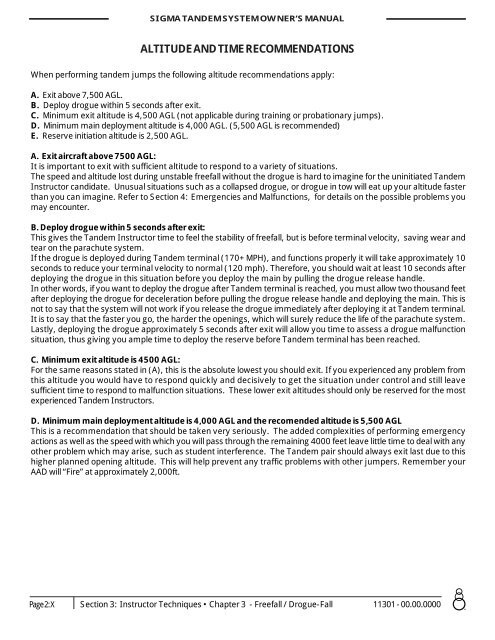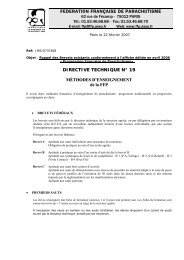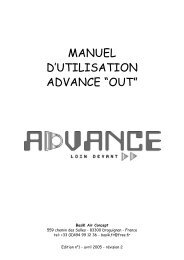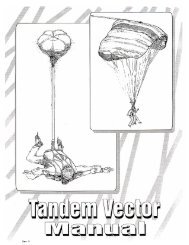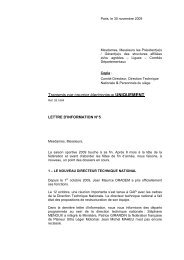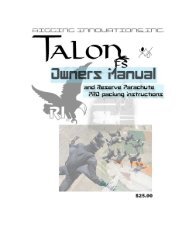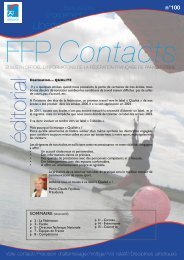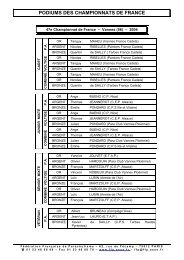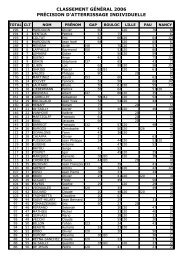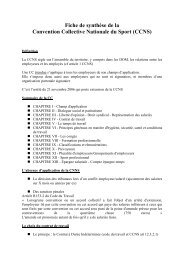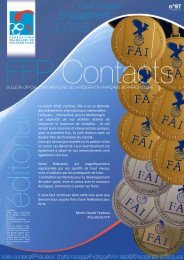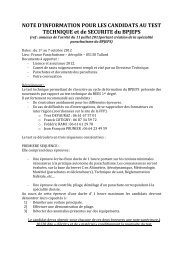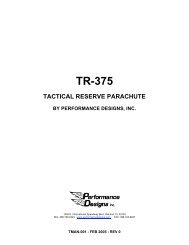tandem vector owner's manual
tandem vector owner's manual
tandem vector owner's manual
Create successful ePaper yourself
Turn your PDF publications into a flip-book with our unique Google optimized e-Paper software.
SIGMA TANDEM SYSTEM OWNER’S MANUAL<br />
ALTITUDE AND TIME RECOMMENDATIONS<br />
When performing <strong>tandem</strong> jumps the following altitude recommendations apply:<br />
A. Exit above 7,500 AGL.<br />
B. Deploy drogue within 5 seconds after exit.<br />
C. Minimum exit altitude is 4,500 AGL (not applicable during training or probationary jumps).<br />
D. Minimum main deployment altitude is 4,000 AGL. (5,500 AGL is recommended)<br />
E. Reserve initiation altitude is 2,500 AGL.<br />
A. Exit aircraft above 7500 AGL:<br />
It is important to exit with sufficient altitude to respond to a variety of situations.<br />
The speed and altitude lost during unstable freefall without the drogue is hard to imagine for the uninitiated Tandem<br />
Instructor candidate. Unusual situations such as a collapsed drogue, or drogue in tow will eat up your altitude faster<br />
than you can imagine. Refer to Section 4: Emergencies and Malfunctions, for details on the possible problems you<br />
may encounter.<br />
B. Deploy drogue within 5 seconds after exit:<br />
This gives the Tandem Instructor time to feel the stability of freefall, but is before terminal velocity, saving wear and<br />
tear on the parachute system.<br />
If the drogue is deployed during Tandem terminal (170+MPH), and functions properly it will take approximately 10<br />
seconds to reduce your terminal velocity to normal (120 mph). Therefore, you should wait at least 10 seconds after<br />
deploying the drogue in this situation before you deploy the main by pulling the drogue release handle.<br />
In other words, if you want to deploy the drogue after Tandem terminal is reached, you must allow two thousand feet<br />
after deploying the drogue for deceleration before pulling the drogue release handle and deploying the main. This is<br />
not to say that the system will not work if you release the drogue immediately after deploying it at Tandem terminal.<br />
It is to say that the faster you go, the harder the openings, which will surely reduce the life of the parachute system.<br />
Lastly, deploying the drogue approximately 5 seconds after exit will allow you time to assess a drogue malfunction<br />
situation, thus giving you ample time to deploy the reserve before Tandem terminal has been reached.<br />
C. Minimum exit altitude is 4500 AGL:<br />
For the same reasons stated in (A), this is the absolute lowest you should exit. If you experienced any problem from<br />
this altitude you would have to respond quickly and decisively to get the situation under control and still leave<br />
sufficient time to respond to malfunction situations. These lower exit altitudes should only be reserved for the most<br />
experienced Tandem Instructors.<br />
D. Minimum main deployment altitude is 4,000 AGL and the recomended altitude is 5,500 AGL<br />
This is a recommendation that should be taken very seriously. The added complexities of performing emergency<br />
actions as well as the speed with which you will pass through the remaining 4000 feet leave little time to deal with any<br />
other problem which may arise, such as student interference. The Tandem pair should always exit last due to this<br />
higher planned opening altitude. This will help prevent any traffic problems with other jumpers. Remember your<br />
AAD will “Fire” at approximately 2,000ft.<br />
Page 2:X Section 3: Instructor Techniques • Chapter 3 - Freefall / Drogue-Fall 11301 - 00.00.0000


